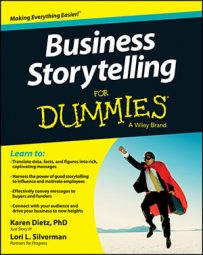When crafting a story for business use, it’s common to be literal in your word choices, which can produce some uninteresting results. Inserting oxymorons, metaphors and similes, analogies, and aphorisms can make your stories more lively, interesting, and entertaining. Figures of speech can help communicate a great deal with just a few words or a phrase.
Here are five questions to ask about your story for each figure of speech:
Could one oxymoron/metaphor/analogy/aphorism be leveraged for your entire story? One way for this to happen is to link it to the theme of the story.
Are there places where an oxymoron/metaphor/analogy/aphorism would enhance languaging and story recall? Look through each paragraph and see if there are opportunities to use them.
Do you want the oxymoron/metaphor/analogy/aphorism to add humor to the story? In what ways can you word it or position it in the story for humor to occur?
Do you want the oxymoron/metaphor/analogy/aphorism to enhance or add additional contrast? In what ways can you do this?
Do you want the oxymoron/metaphor/analogy/aphorism to add human-like qualities to inanimate or non-human entities (personification)? Personification is a way to give real-life or human-like qualities to objects: The waterspout danced across the ocean. Or: The tiger glided along like a graceful ice skater. In what ways might you be able to do this in your story?
Oxymorons
Oxymorons link two seemingly contradictory words together into the same phrase. One of the most common examples is the phrase pretty ugly. Others include phrases like true lies, military intelligence, deafening silence, and a new classic. These are all forms of contrast.
Instead of simply saying, “When we got on, it was very hot. Normally an auxiliary power until keeps the plane cool while it’s on the ground. But either they didn’t have one or it was broken” add “It was a fine mess” to the end of the paragraph after shortening the wording. Fine mess is an oxymoron and sums up the situation nicely while tickling our funny bone.
Notice that this oxymoron represents an emotion that people in the situation are feeling without having to explain a lot. When you’re crafting really short stories, you’ll find that all the figures of speech can help in this manner. Take another look at your story. In what ways could you use an oxymoron?
Metaphors and similes
Jumping for joy. The apple of my eye. Leaping with laughter. His stomach is a bottomless pit. All are examples of commonly used metaphors.
Metaphors are when one thing is represented as, named as, or symbolically linked to something else. Our brains are stimulated by the juxtaposition as we play with linking them together to create a new picture and new meaning. Try this on for size. Reflect for a moment on what comes to mind when you hear the phrase you’re the light of my life.
Avoid these common mistakes when using metaphors:
Steer clear of common, trendy, and overused metaphors like fiscal cliff. They won’t have the level of impact you may need for your story.
Avoid metaphors your audience won’t understand. If they don’t know what purgatory is, then saying, “The team was headed into perpetual purgatory” will be meaningless.
Don’t mix metaphors in the same sentence. Replace “Our team was digging for treasure when our ship came in” with “Our team was digging for treasure when we struck gold.”
Metaphors are very similar to but not quite the same as similes. A metaphor says that something is something else without using the words like or as. For example, “Your report is a bowl of bland oatmeal” is a metaphor. The simile would be, “Your report is like a bowl of bland oatmeal.”
Some metaphors and similes connect an abstract thought to something concrete and experiential. They help construct meaning and structure thought. Consider these metaphors: time (abstract) is money (concrete) and his ideas (abstract) bore fruit (concrete); and these similes: as gentle (abstract) as a lamb (concrete) and as smart (abstract) as a fox (concrete).
Analogies
Analogies make comparisons in slightly different ways by using contrasting elements. An analogy is a similarity between like features of two things, so a memorable comparison may be made. Here are a few examples:
An annoying voice is akin to nails on a chalkboard.
What a general is to an army, a CEO is to a company.
Pen is to paper as a keyboard is to a computer.
Aphorisms
Aphorisms are pithy observations that contain a general truth, much like a proverb. A penny saved is a penny earned and A man is known by the company he keeps are aphorisms.
For example, here are some aphorisms (sometimes called proverbs) about service:
No act of kindness is too small.
A good word costs no more than a bad one.
Extending a hand into the darkness can pull another into the light.
Pay it forward.
You could use no act of kindness is too small.
Take another look at your story. Is there an aphorism that lends itself to the theme you’ve chosen?

